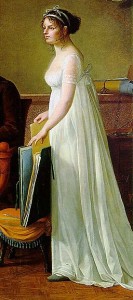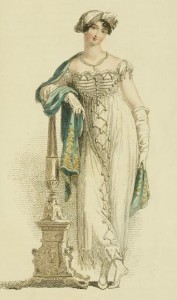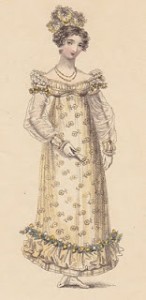Regency fashions are so iconic that one can tell at a glance if a clothing ensemble is from that era.

The easiest thing to spot is, as one would suppose, on the women’s fashions. During this time period the waist of dresses rose higher and higher until it rested just under the bust. This was a drastic change from the heavily corseted fashions that preceded and followed the Regency era.
But why the change? What spurred a three decade shift away from the structured gown to the flowing silhouette we know and love?
Greece and France.
While the English might not want to move to France or have Napoleon take over their country, there were plenty of French things they did like. Fashion was one of them. So when French ladies began emulating paintings of Grecian goddesses in their fashions, England followed suit.
The Grecian influence can be easily seen in some of the first high waisted dresses from the early 1800s. Crossed trimmings, geometric shapes, even shawls and drapes hearkened back to the depictions of Aphrodite and Queen Hera.

Gradually these Grecian influences softened as designs strove to be new and different each year. As the war began, military stylings began to appear. Frog closures, military trimming, and even boxier shoulders made an appearance. As this happened, the waistline crept ever higher, until there was little to be called a waist for it fell so close to the bust line.
Skirts tended to flow close to the body, lending themselves to many a cartoon about the potential risqueness of the fashion.

After the war, the British once more traveled to France and incorporated their fashion trends. The skirt belled out a bit more, forming a A-line shape. The waist also began to lower. Inch by inch, year by year, it crept back down to it’s original position. Ruffles and voluminous shoulders and necklines appeared. Corsets finally returned and the waistline went from rising and falling to shrinking.
I have to think that if you were a young woman who had grown up in the looser clothing of the Regency, the fashion requirement of lacing corsets would have been a harsh adjustment.
What do you think? Do you like a high waistline? Wish the free-flowing, high-waisted gown would make a fashion comeback?
Originally posted 2013-03-11 10:00:00.